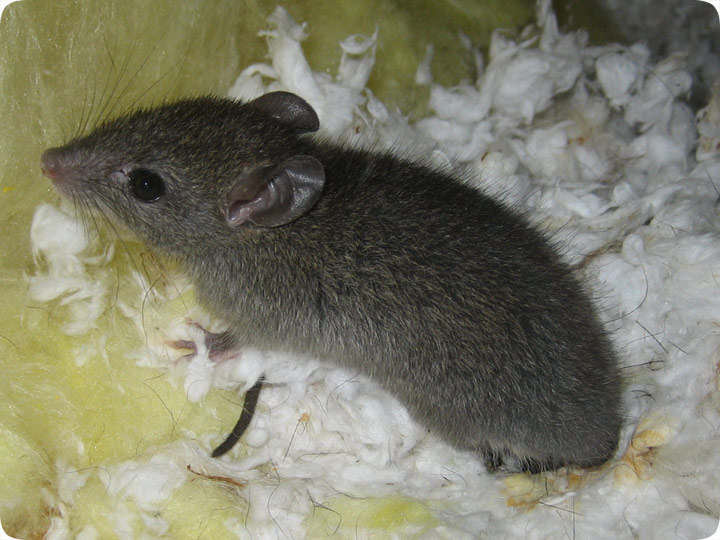-
info@aaanimalcontrol.com
Call us for help in your town
Humane Wildlife Education
Mouse Nest In Attic

06.27.2006 - One of the reasons rodents such as rats and mice enter an attic is in order to have a place to create a nest and have babies. This is actually the primary reason certain animals, like raccoons and opossums use attics. Rodents tend to use attics regardless, but
as with any animal, they create their nests in convenient and safe places, so if you have rats or mice in your attic, there's a good chance that some of the adult females have created nests.
I've seen several different rat and mouse nests in attics so far. The nest usually
consists of a cluster of shredded debris, often loosely arranged or in a bowl-shaped form, like a bird nest. I've seen nests that consist of shredded newspaper, string, hair, and attic insulation.
The nest in this photo is below the mouse. She's sitting on the eggs in hopes of
hatching them. Of course that's not true, and no rodent would defend a nest. Rats and mice will flee anything at the first slight sign of danger. Anyway, I once had a customer who was so ignorant about wildlife that she suggested that the raccoons in her attic would survive by
eating insulation, and she was concerned that the raccoon would lay eggs up in her attic. There's a lot of ignorance about the wild animal world all around us (and in this case, above us), but that was a bit over the top for me.
If I see a rat or mouse nest in the attic
during a rodent control job, I will remove it, but most of the time I do not find any nests, possibly because they are tucked away, hidden underneath insulation.
Do it yourself: Visit my How To Get Rid of Mice page for tips and advice.
Get professional help: Visit my Nationwide Pro Directory of wildlife removal experts.
For more wildlife stories, click my Wildlife Blog
or click my below banner to hire a local trapper.
Mice love living with humans! Because of the free food and living space, man-made structures are like a 5-star hotel that they can live in undisturbed. They see attics as the perfect place to breed and give birth to many babies.
Attics, in particular, is a mouse's favorite spot to live in. This is because of multiple advantages that they enjoy including the quietness, the temperature, and the absence of people disturbing them. A mouse infestation in your attic can be troublesome because of all the possible dangers that they can cause to your home as well as some health hazards that may be detrimental to you and your family's health.
Now, we will be discussing how these little rodents manage to get to your attic, the reasons why they like nesting in the attic, the signs you should look for to confirm that you are dealing with a mouse infestation, and some tips on how to get rid of this problem.
How do they get in the attic?
Mice are tiny and agile animals. This advantage makes almost all man-made structures possible to enter. Thanks to their size, mice can fit in spaces as small as a quarter making all cracks, holes, crevices, and damaged walls as entry points that they can enter through.
Also, shrubs that are attached to your home or hanging branches near your home serve as “stairs” to enter your house.
Reasons on why they settle in attics
The first reason is practicality - because it's much warmer since heat rises to the attic inside your home. Because of their feeble nature, the obscure and quiet environment is perfect for them.
They will tend to hide in boxes where they will gnaw on it and destroy all the items stored in your attic. Lastly, no one will say no to free food! Thanks to humans, the mouse has a steady source of food and they will continually eat unattended food and crumbs.
Signs of mice in the attic
The noise of their tiny feet, chewing, scratching, and mouse squeaking will be the first indicator in determining their presence. Of course, the pungent smell of their droppings and urine will greet you on where they're prevalent.
Grease marks and footprints will leave a mark of dark smears on your boxes and items. If you have a dusty attic, mice will also leave footprints in the dust.
But undeniably their mere presence or physical evidence like chewed up furniture, packaging, and damaged insulation is the ultimate sign that mice are nesting inside your attic.
Effective methods in dealing with mice nesting in your attic:
Cut off entry points.
Patch up any holes or possible entryways like crevices, holes, and vents. By doing this, you will be preventing any future infestations.
Tidy up your home.
A mouse can live on crumbs and any unclean floor or kitchen station. This is also a preventive method that will make them think twice and there will be no more free food!
Contact exterminators.
If you don't want to deal with these little animals, don't worry! It may be a little pricey but, having a professional dealing with your mouse problem is the easiest way to go.




















